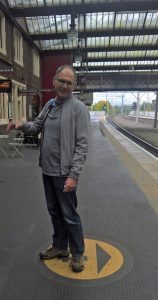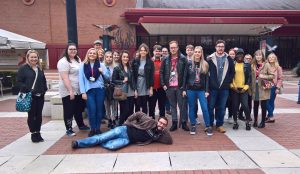The Sonnets are Shakespeare condensed into small scale poetic form. Their performance space is not on the playhouse stage, but in the more expansive theatre of the mind, portable Shakespeare, therefore, for the modern bookreader, to be accessed anywhere and whenever. Compiled inside the covers of one book, the 154 poems, 14 lines each, provide a lyrical backdrop to Shakespeare’s theatre, a sort of engine room or microcosm of nuclear ideas that power the universe of the plays. Of course they also demand to be enjoyed in their own right. For, first and foremost, this is great poetry: something else Shakespeare, the playwright polymath, was exceptionally good at, even though various juries are still out whether all of The Sonnets are of equally high artistic quality. As is the case with numerous other aspects of Shakespeare’s work,The Sonnets carry some unanswered questions regarding sources, origins, authorship, publication, purpose, sexual orientation even, order of arrangement of the sequence and of individual poems in the collection, its dedication, addressees etc.. To pick out but one area: who, for example, was the dedicatee of the collection, the enigmatic ‘Mr W.H.’ (the most recent research-based claim suggests he was a friend of the author, a London publisher called William Holme), or, in another contentious area, who was the young man the first 126 sonnets are addressed to (was there even a physical role model, and what, if there was?); and who was the mysterious ‘Dark Lady’ of the last 28 ones? As first port of call, introducing some of the ins and outs of the text, W. H. Auden’s ‘Afterword’ to the Everyman’s Library edition may serve: a poet’s perspective on the poems…
The sonnet as a new poetic form originated in 13th century Italy. Its invention can be regarded as one of the most substantial literary achievements of early modern culture, with a first peak of artistic perfection in the Canzoniere of Petrarca (written between 1327 and 1368). In fact, it has been argued that the sonnet as an artistic landmark points to the beginning of the Renaissance as such… Since then the form has enjoyed several high points along the way to later modern writing, Shakespeare’s collection of 1609 being one of them, of course; also, Elisabeth Barrett-Browning’s 1850 Sonnets from the Portuguese needs a mention, and, most recently, in 2015, Don Patterson’s excellent collection of 40 Sonnets. Almost everybody who was (and is) anybody in the world of poetic writing has at some stage used the sonnet. Its specific formal features demand of the poet a high degree of skill and good craftsmanship; it lends itself particularly well to the display of poetic virtuosity. You can make a good name for yourself, even aspire to enter into the afterlife of everlasting poetic fame, or become a Poet Laureate, if you manage to compose decent sonnets. Contemporary likenesses convey Petrarch as the bearer of the laurel wreath, the ancient Apollonian crown for heroes and champion poets. The other reason is that owing to the peculiarities of its intricate structure and patterning, the Petrarchan sonnet and its Shakespearean modification have served as a model form for expressing complex thoughts, sentiments and feelings: the sonnet is a modern poetic form because it allows particularly well for an expression of the issues that are on the modern mind.
The modernity of the sonnet as a form lies in the fact that it is eminently suitable to deal with questions of conflicted human identity in an increasingly confusing world of post medieval secularisation, a world we are still living in today. The discourse-oriented, bipartite structure of the Italian sonnet (Octave – two Quatrains – followed by Sestet – two Tercets) and the possibilities of fugue-like intertwining of rhymes (across the different intersections) allows for great flexibility in expressing condensed, complex ideas, often of an antithetical, or oxymoronic and paradoxical nature, and encourages the development of a complicated argument, that may extend from initial statement via discussion in the Octave down to a resolution at the end of the Sestet. Shakespeare modifies the Petrarchan model. Replacing the two-part structure (Octave and Sestet), he introduces three Quatrains and one final Couplet, which, it can be argued, even increases the sonnet’s propensity for intellectual disputation and the charting of thoughts as a ‘dialectical’ process, with negation, self-doubt, and contradiction as ingredient elements. Arguably, through its essentially tripartite structure (plus concluding couplet), the Shakespearean paradigm of the sonnet, even more so than the more binary-based Petrarchan, caters even better for the requirements of dynamically developing, modern thought and a fluid argumentation. Like most of his plays, Shakespeare’s sonnets use iambic pentameter, the metrical line that hides its own constructedness and aims at giving the illusion of life-like speech. It also brings The Sonnets in proximity to the plays in that it enhances the dramatic positioning of the ideas discussed in them. Their rhyme scheme mostly follows the pattern of abab cdcd efef gg.
Sonnet 65 is one of my favorites.
Shakespare
SONNET 65
Since brass, nor stone, nor earth, nor boundless sea,
But sad mortality o’er-sways their power,
How with this rage shall beauty hold a plea,
Whose action is no stronger than a flower?
O, how shall summer’s honey breath hold out
Against the wreckful siege of battering days,
When rocks impregnable are not so stout,
Nor gates of steel so strong, but Time decays?
O fearful meditation! where, alack,
Shall Time’s best jewel from Time’s chest lie hid?
Or what strong hand can hold his swift foot back?
Or who his spoil of beauty can forbid?
O, none, unless this miracle have might,
That in black ink my love may still shine bright.
To me it stands out as one of the most radically modern of Shakespeares utterances, through its imagery, for a start, which seems to point forward as far ahead as Victorian Industrialisation and Darwinian Geology. But also through the depth of what is being discussed in it: at the root is a central question still asked in a similar way (and sometimes answered), perhaps asked again for the first time in this radical way since Shakespeare’s days, in European art and thought around the middle of the 19th century and beyond. Art, poetry to be precise, holds out the faint hope of permanence and constancy in the face of the great ravisher Time who causes all human life and its products to be annihilated. The human counts for nothing in a world of raging natural devastation where even rocks erode over time, let alone brass and steel: hope against hope, the poet writes against the inevitability of natural decay, and perhaps there is a slim chance for poetic passion, codified in the black ink of the written text, to survive the tumult of destruction and shine through it.
The notion of transience of life is as widespread in the European literature of the Baroque as that of teatrum mundi (‘All the Word’s a stage’, in the words of one of Shakespeare’s plays), both ideas feeding into the modern notion of tragic absurdity of life. Thus, as Walter Benjamin emphasised in his study of Baroque tragedy, the literature of Shakespeare’s period paves the way into our own time. However, Sonnet 65 seems to me to go particularly deep in its modern concerns, perhaps further than other discussions of the matter in Shakespeare and other contemporary writers, such as Cervantes, Calderon or Grimmelshausen. This sonnet strikes me particularly through its visionary qualities, enhanced by its peculiar network of metaphors, directly anticipating, down to the phrase almost, many later expressions of the same dilemma from poets and writers who were neck-deep embroiled in the battles for orientation and identity during Industrial Revolution and later Capitalism, the worst times of turmoil and change of the whole period. Marx, no poet, comes out with the stunning well-known poetic line, ‘All that is solid melts into air’ (1848), a fact, he maintains with the characteristic optimism of the early freedom fighter, that we can, waking up to realising our own situation, turn into our advantage. From Sonnet 65, links can be drawn to Darwin who propagates the notion of ‘geological time’ in Origin of Species (1859); The sentence from the same source: ‘How fleeting are the wishes and efforts of man! how short his time! and consequently how poor will his products be, compared with those accumulated by nature during whole geological periods’, chimes with the sentiments of the Sonnet. It also anticipates late-19th century Aestheticism which, counteracting the pessimism of Darwin’s biological determinism, identifies a faculty in the make-up of the human that may provide a reason to live in a devastating world of destruction, by resisting ‘Nature, Red in tooth and claw’ (Tennyson’s phrase from In Memoriam, 1850). In the famous Conclusion to The Renaissance (1873) Walter Pater says that
‘we have an interval, and then our place knows no more. … Great passions may give us a quickened sense of life, ecstasy and sorrow of love, the various forms of enthusiastic activity, disinterested or otherwise, which comes naturally to many of us. … Of such wisdom, the poetic passion, the desire of beauty, the love of art for its own sake, has most. For art comes to you proposing frankly to give nothing but the highest quality to your moments as they pass, and simply for those moments’ sake.’
There is a variety of connections that can be made between Sonnet 65’s desperate vision of hope that art may resist the destruction of time to similar reflections in 19th century poetry. Canto V of Tennyson’s In Memoriam (1850) echoes the Sonnet’s idea of fragile ink set against overwhelming devastation. Tennyson, who thinks of his own poems as ‘lullabies of pain’, holds that
But for the unquiet heart and brain,
A use in measured language lies;
The sad mechanic exercise,
Like dull narcotics, numbing pain.
In words, like weeds, I’ll wrap me o’er,
Like coarsest clothes against the cold:
But that large grief which these enfold
Is given in outline and no more.
If at all, it is only through art that the human has any significance, any distinct part to play in the grand scheme of things. In Shakespeare’s Sonnet 65 the dim glow of the black ink of poetry is the only light source in a world of cosmic devastation and universal darkness. The same black sun of poetry shines from Baudelaire’s Les fleurs du mal (1857), and more, powerfully black even, from James Thomson’s City of Dreadful Night (1874). In an early poem called ‘Hap’ of 1866, Hardy calls Time a ‘purblind Doomster’: this is the major ingredient also in all of Hardy’s novels. Time in Hardy is the modern equivalent of ancient fate in a post-mythological and post-Christian age, the main agent (together with chance, or ‘Happenstance’ – the shortened title of the poem ‘Hap’) that turns human life into tragedy, even under the most modern of conditions.
















